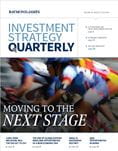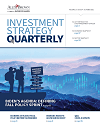Will the Fed hit its 2% inflation mark?
Chief Economist Eugenio Alemán and Economist Giampiero Fuentes note that while it is taking longer to bring inflation down, the Fed will continue to conduct monetary policy to reach its target rate.
To read the full article, see the Investment Strategy Quarterly publication linked below.
Key Takeaways:
-
The Federal Reserve (Fed) estimates that 2% for the Personal Consumption Expenditure (PCE) price index over the long run is the most favorable rate of inflation to support one of the institution’s dual mandates: price stability. The Fed’s second mandate is to keep the rate of unemployment as low as possible.
-
Over time, there has been an inverse relationship between the rate of inflation and employment. If the rate of unemployment is too low, the rate of inflation would tend to increase, and vice versa. This is known as the Phillips Curve. But this relationship has broken down and a question for the Fed is whether the Phillips Curve will once again apply.
-
Inflation occurs when there is a generalized increase in the level of prices in an economy. There are two ways in which inflation occurs, ‘cost-push inflation,’ which occurs when there is an increase in the cost of production in an economy, and ‘demand-pull inflation,’ which is when the demand for goods increases.
-
Inflation has increased to the highest level in 40 years mostly due to consequences of the pandemic, including product shortages, supply chain disruptions, highly expansive fiscal policy, and strong consumer demand. Once these things normalize, inflation should return to the Fed’s long-term target.
-
The Fed is going to conduct monetary policy to reach its target rate of inflation. It is not going to change the target.
Inflation targeting was pioneered by New Zealand in the late 1980s as the country underwent significant economic and financial market reforms. The primary goal was to maintain price stability by targeting inflation between zero and 2%, with the range allowing the country’s Reserve Bank (its central bank) to accommodate volatility and external shocks. However, despite the flexibility, the Reserve Bank ultimately changed its targeting goal to 2%, providing more clarity to the public and policymakers. This experience with inflation targeting influenced central banks worldwide, including the Fed, which declared its 2% inflation target in 2012.
The Fed estimates that two percent for the Personal Consumption Expenditure (PCE) price index over the long run is the most favorable rate of inflation to support one of the institution’s dual mandates: price stability. The second mandate is to keep the rate of unemployment as low as possible. But the biggest issue for the Fed is that in general, and over history, there has been an inverse relationship between the rate of inflation and employment. If employment is too strong – that is if the rate of unemployment is too low – the rate of inflation would tend to increase, and vice versa. This is what is normally called the Phillips Curve.

But this relationship has broken down over the last several decades. During the pre-COVID-19 pandemic years, the US was able to keep inflation under the 2% target while at the same time keeping the rate of unemployment at uncharacteristically low levels compared to the historical Phillips Curve relationship. Thus, the question for the Fed today is whether we will go back to a pre-pandemic relationship between inflation and unemployment or if the Phillips Curve relationship will once again apply.
This time is no different
Over the last two years, inflation has increased to the highest level in 40 years mostly due to consequences of the pandemic, including product shortages, supply chain disruptions, highly expansive fiscal policy, and strong consumer demand. However, once all of the above return to somewhat normal levels, inflation should return to the Fed’s long-term target. Perhaps one of the biggest issues affecting inflation is immigration, which was severely curtailed due to COVID-19 but has returned to somewhat normal levels over the last year or so. Although the labor force participation rate overall collapsed during the COVID-19 pandemic, the recent improvement in labor force participation will help normalize the U.S. labor market going forward.

The bottom line
The rate of inflation, after remaining below the Fed’s 2% target for several years, has remained above target due to the severe COVID-19 pandemic shock and its policy aftermath. Although the Fed was caught off guard and reacted tardily to its inflationary impacts, the disinflationary process started in July of 2022 and has continued ever since.
It is true that inflation has remained above target for more than two years and thus it will take a longer to bring down, but the process is guaranteed by the Fed’s commitment to achieving its 2% target over the years and thus, there is nothing – other than sticking to the target – that the Fed has to do to achieve that target.

Read the full
Investment Strategy Quarterly
All expressions of opinion reflect the judgment of the Chief Investment Office, and are subject to change. This information should not be construed as a recommendation. The foregoing content is subject to change at any time without notice. Content provided herein is for informational purposes only. There is no guarantee that these statements, opinions or forecasts provided herein will prove to be correct. Past performance may not be indicative of future results. Asset allocation and diversification do not guarantee a profit nor protect against loss. The S&P 500 is an unmanaged index of 500 widely held stocks that is generally considered representative of the U.S. stock market. Keep in mind that individuals cannot invest directly in any index, and index performance does not include transaction costs or other fees, which will affect actual investment performance. Individual investor’s results will vary. Investing in small cap stocks generally involves greater risks, and therefore, may not be appropriate for every investor. International investing involves special risks, including currency fluctuations, differing financial accounting standards, and possible political and economic volatility. Investing in emerging markets can be riskier than investing in well-established foreign markets. Investing in the energy sector involves special risks, including the potential adverse effects of state and federal regulation and may not be suitable for all investors. There is an inverse relationship between interest rate movements and fixed income prices. Generally, when interest rates rise, fixed income prices fall and when interest rates fall, fixed income prices rise. If bonds are sold prior to maturity, the proceeds may be more or less than original cost. A credit rating of a security is not a recommendation to buy, sell or hold securities and may be subject to review, revisions, suspension, reduction or withdrawal at any time by the assigning rating agency. Investing in REITs can be subject to declines in the value of real estate. Economic conditions, property taxes, tax laws and interest rates all present potential risks to real estate investments. The companies engaged in business related to a specific sector are subject to fierce competition and their products and services may be subject to rapid obsolescence.

